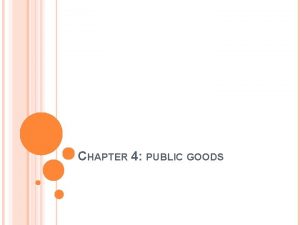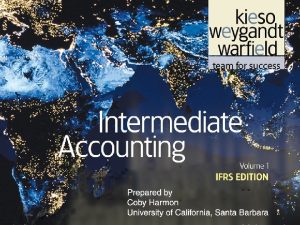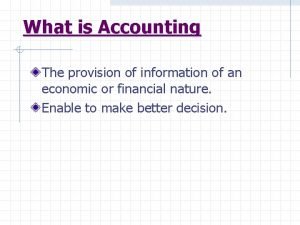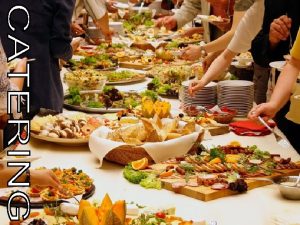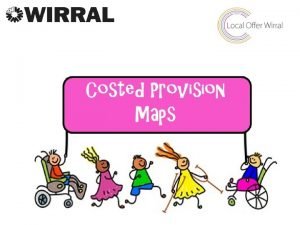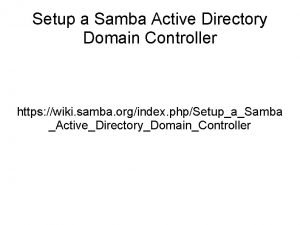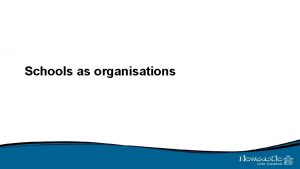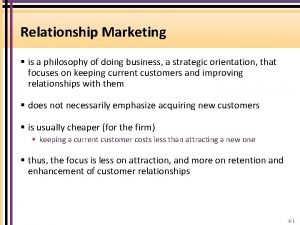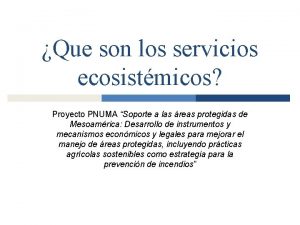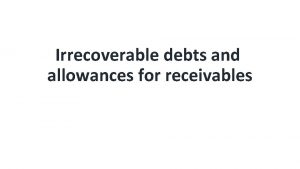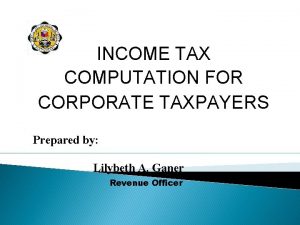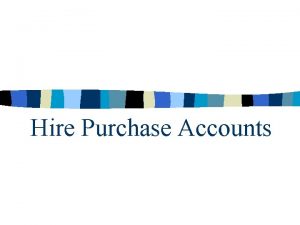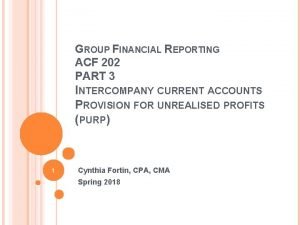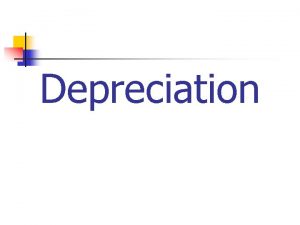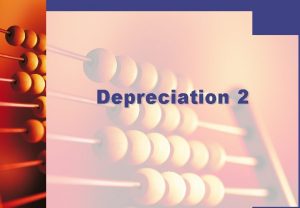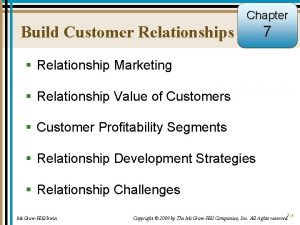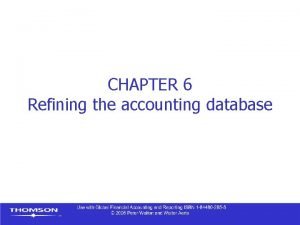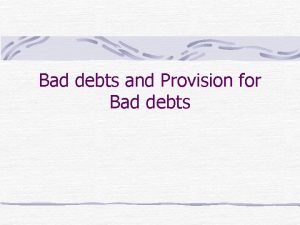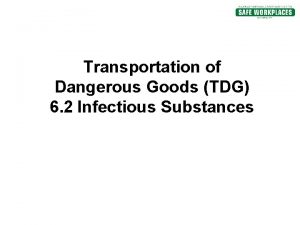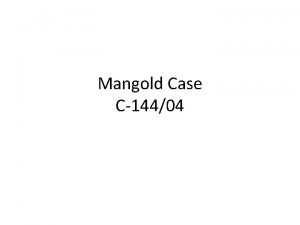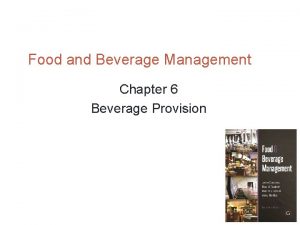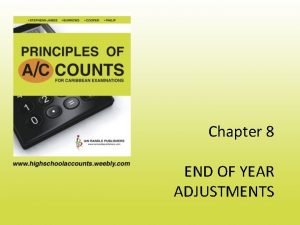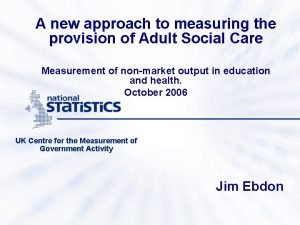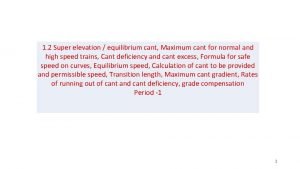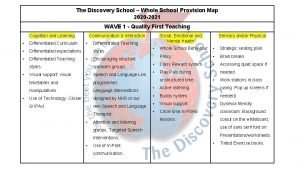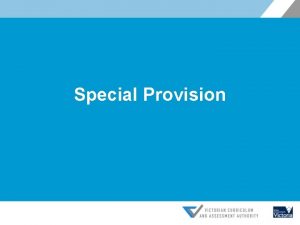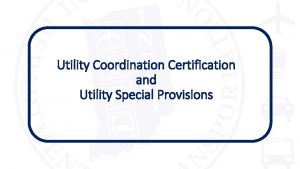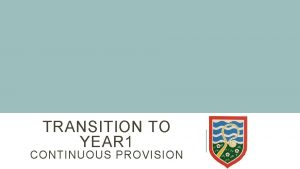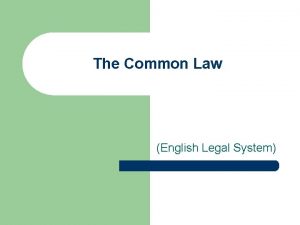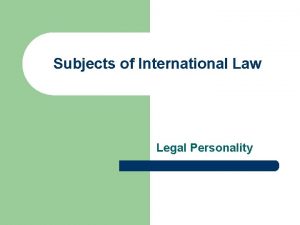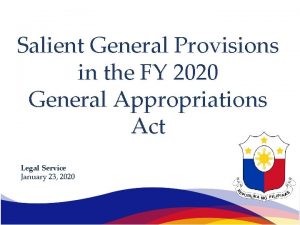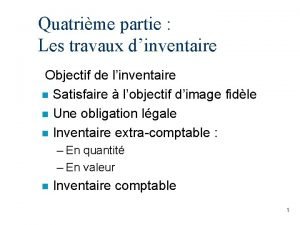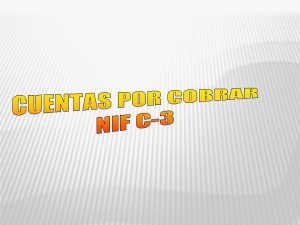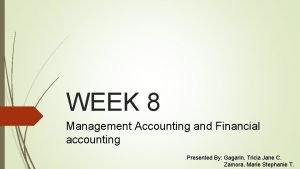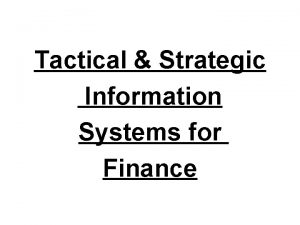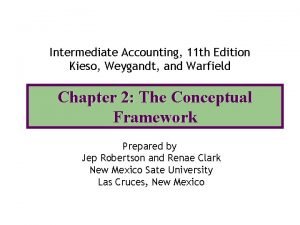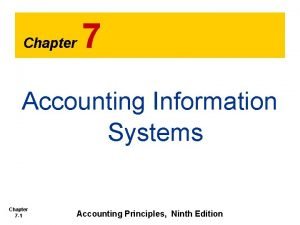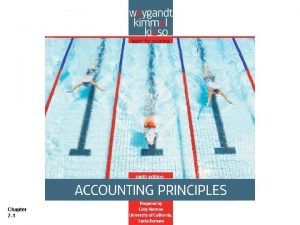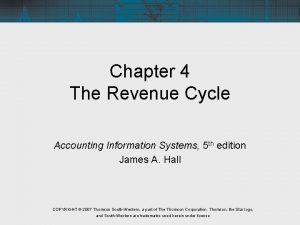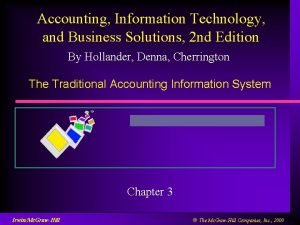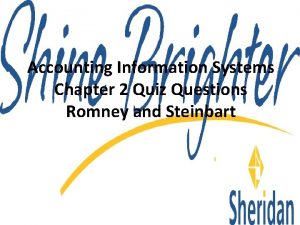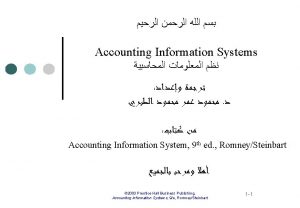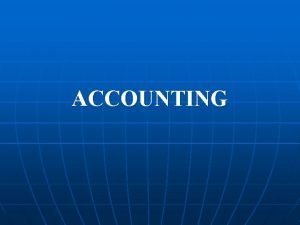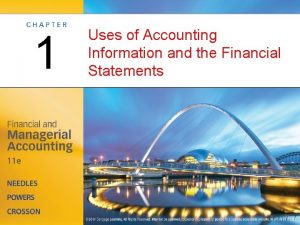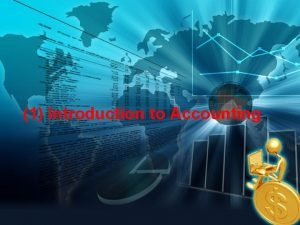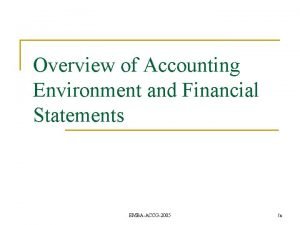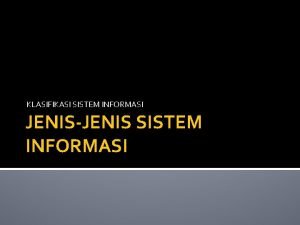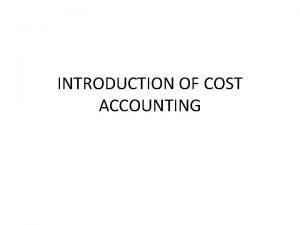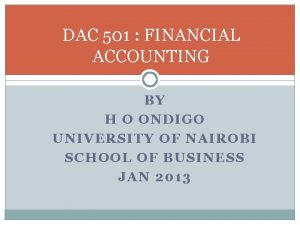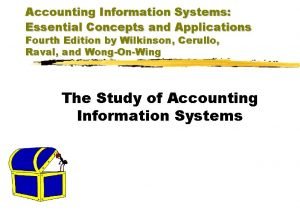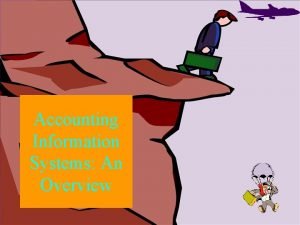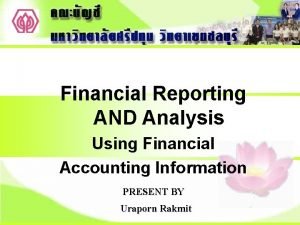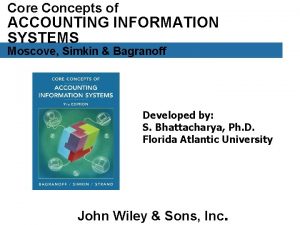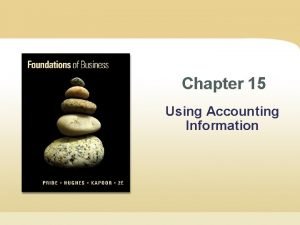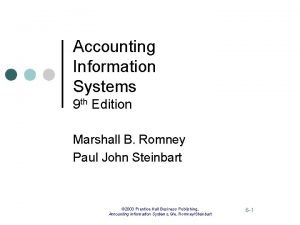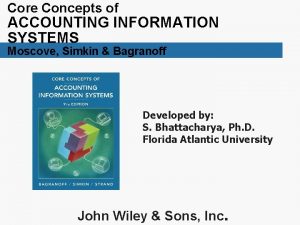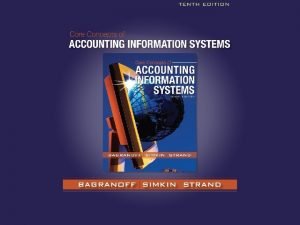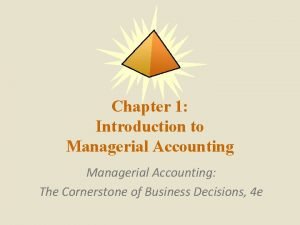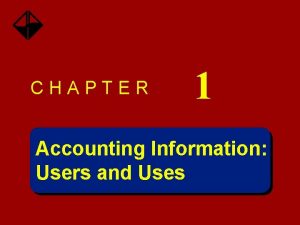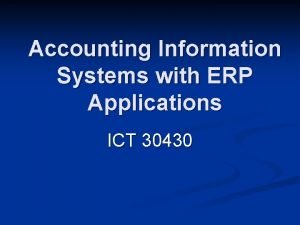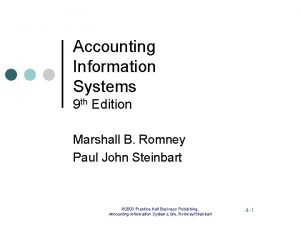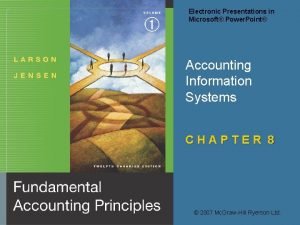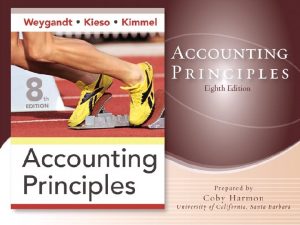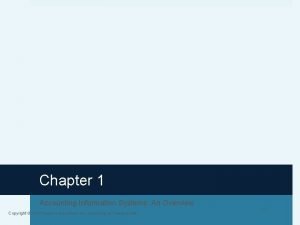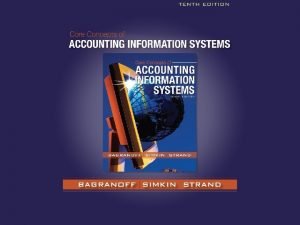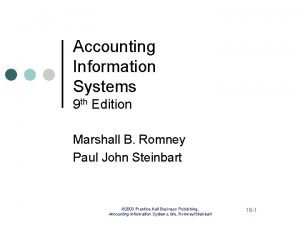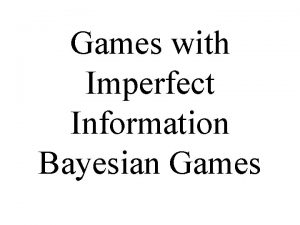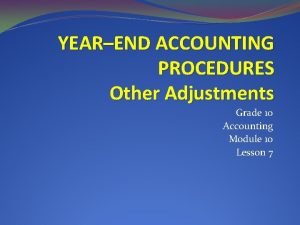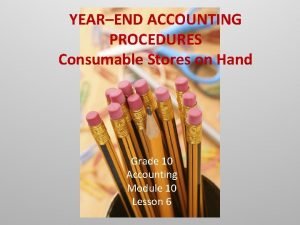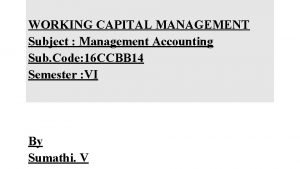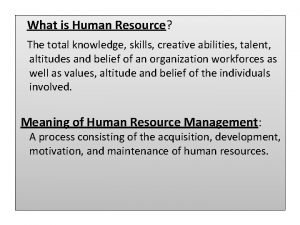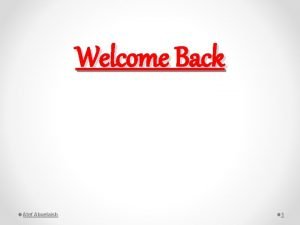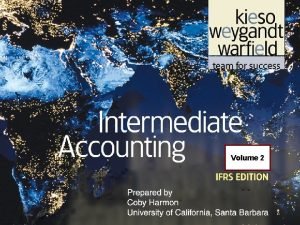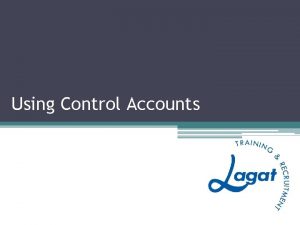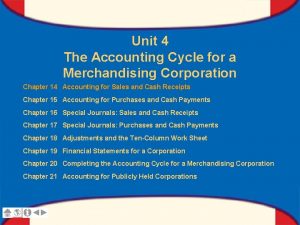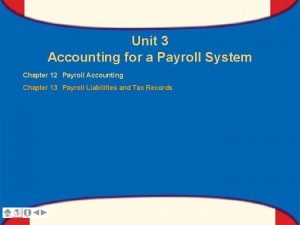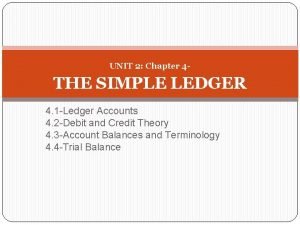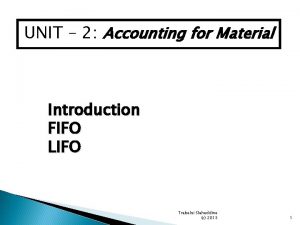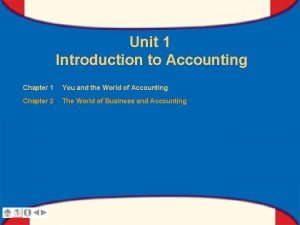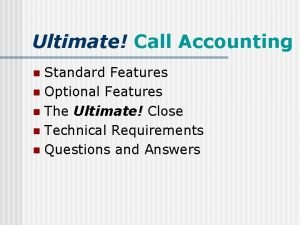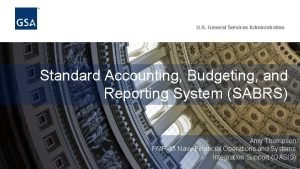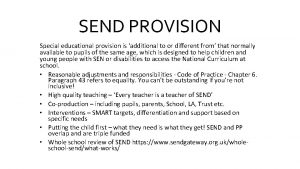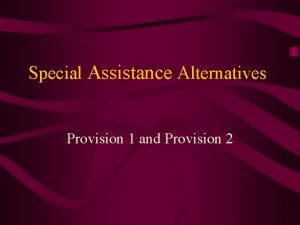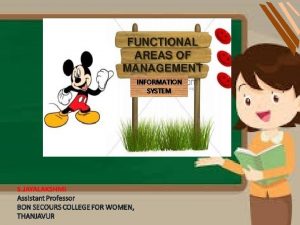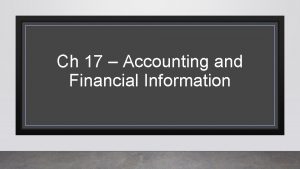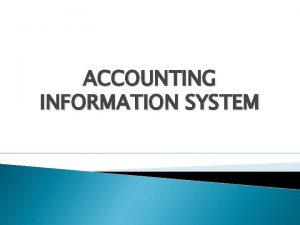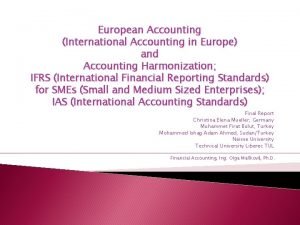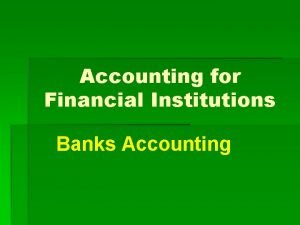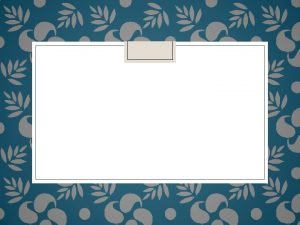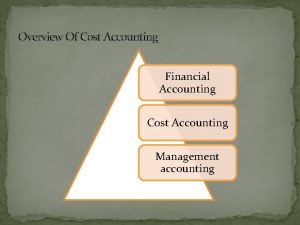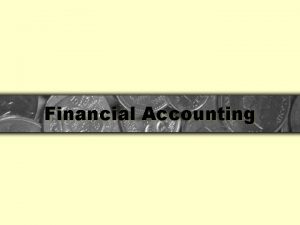What is Accounting The provision of information of






















































































































































- Slides: 150

What is Accounting The provision of information of an economic or financial nature. Enable to make better decision.

What is Bookkeeping Book-keeping is the process of recording the monetary worth of business transactions in the books of accounts. It is the record-making phase of accounting.

The Major Users of Accounting Information Owners Management Lenders Suppliers of Goods and Creditors Customers Competitors Government Employees The Public

Accounting Equation Assets (Resources in the business) = Capital + (Resources Supplied by the owner) Liabilities (Resources Supplied by outsiders)

The Balance Sheet The expression of the accounting equation

Example The introduction of capital 1 July 1997 Peter opened a bank account for this new business and paid in a cheque of $40, 000 as his investment in the business.

Example The purchase of stock by cheque 4 July 1997 The business bought goods for resale of $5, 000 by cheque.

Example The purchase of stock by incurring a liability (i. e. deferring payment) 10 July 1997 The business bought goods $10, 000 on credit from P. Tang.

Example Sale of stock for cash 20 July 1997 Sold goods for cash $4, 000.

Example Sale of stock on credit 22 July 1997 Sold goods on credit to ABC Ltd. $1, 000.

Example The settlement of a liability 25 July 1997 Paid money owing to P. Tang by cash $4, 000.

Double-Entry System Every transaction affects two items in the balance sheet.

The Format of an Account (i) Traditional Format “T form” • • The left-hand side is called the debit side. The right-hand side is called the credit side. (ii) Computerized Format

Assets They are economic resources which provide benefits to the business.

Assets Fixed Assets Current Assets

Fixed Assets Intangible Fixed Assets Tangible Fixed Assets

Intangible Fixed Assets E. g. Goodwill Patents Franchises Royalties Development Expenditures

Tangible Fixed Assets E. g. Land Buildings Premises Furniture & Fittings Office Equipment Machinery Motor Vehicles Long-term Investments

Current Assets E. g. Stock Debtors Current Investments Prepaid Expenses Bills Receivable Accrued Income Bank/Cash

Liabilities They are debts or obligations owed by the business to outside parties.

Liabilities Long-term Liabilities (Repayable beyond the next accounting year) Current Liabilities (Repayable within the next 12 months)

Long-term Liabilities E. g. Debentures Bank Loans from Others

Current Liabilities E. g. Creditors Accrued Expenses Prepaid Income Bank Overdrafts

Capital is what the company owed to the owners. It is a liability of the business to its owners.

Any asset account Increase Decrease + Any liability account Decrease Increase - + Capital account Decrease Increase - +

Example (A) 1 May 2004 n Transaction w Started an engineering business putting $1, 000 into a bank account. n Effect w Increases asset of bank w Increases capital of owner n Action w Dr. Bank account w Cr. Capital account

Bank 2004 May 1 Capital $ 1000 Capital 2004 May 1 Bank $ 1000

Example (B) 3 May 2004 n Transaction w Bought machinery on credit from Unique Machines $275. n Effect w Increases asset of machinery w Increases liability to Unique Machines n Action w Dr. Machinery account w Cr. Unique Machines account

Machinery 2004 $ May 3 Unique 275 Unique Machines (Creditor) 2004 $ May 3 Machinery 275

Example (C) 4 May 2004 n Transaction w Withdrew $200 cash from the bank and placed it in the cash box. n Effect w Increases asset of cash w Decreases asset of bank n Action w Dr. Cash account w Cr. Bank account

Cash 2004 May 4 Bank $ 200 Bank 2004 $ May 1 Capital 1000 2004 May 4 Cash $ 200

Example (D) 7 May 2004 n Transaction w Bought a motor van paying in cash $180 n Effect w Increases asset of motor van w Decreases asset of cash n Action w Dr. Motor Van account w Cr. Cash account

2004 May 7 Cash 2004 May 4 Bank Motor van $ 180 Cash $ 2004 May 7 200 $ Motor van 180

Example (E) 10 May 2004 n Transaction w Sold some of the machinery for $15 on credit to S. Au. n Effect w Increases asset of money owing by S. Au w Decreases asset of machinery n Action w Dr. S. Au’s account w Cr. Machinery account

S Au (Debtor) 2004 $ May 10 Machinery 15 Machinery 2004 May 3 Unique $ 275 2004 May 10 S Au $ 15

Example (F) 21 May 2004 n Transaction w Returned some of the machinery, value $27, to Unique Machines. n Effect w Decreases liability to Unique Machines w Decreases asset of machinery n Action w Dr. Unique Machines w Cr. Machinery account

Machinery 2004 $ 2004 May 3 Unique Machines (B) 275 May 10 S. Au (E) $ 15 May 21 Unique Machines (F) Unique Machines (Creditor) 2004 May 21 Machinery $ 27 2004 May 3 Machinery $ 275 27

Example (G) 28 May 2004 n Transaction w S. Au paid the firm the amount owing, $15, by cheque. n Effect w Increases asset of bank w Decreases asset of money owing by S. Au. n Action w Dr. Bank account w Cr. S. Au’s account

S. Au (Debtor) 2004 May 10 Machinery (E) $ 2004 15 May 28 Bank (G) $ 15 Bank 2004 May 1 Capital May 28 S Au $ 1000 15 2004 May 4 Cash $ 200

Example (H) 30 May 2004 n Transaction w Bought another motor van paying by cheque $420. n Effect w Increases asset of motor vans w Decreases asset of bank n Action w Dr. Motor van account w Cr. Bank account

2004 May 7 Cash May 30 Bank Motor van $ 180 420 Bank 2004 May 1 Capital May 28 S Au $ 1000 15 2004 May 4 Cash May 30 Motor van $ 200 420

Example (I) 31 May 2004 Transaction n Paid the amount of $248 to Unique Machines by cheque. Effect n n Decrease liability to Unique Machines Decrease asset of bank Action n n Dr. Unique Machines Cr. Bank account

Bank $ 2004 1, 000 May 4 Cash (C) 2004 May 1 Capital (A) May 28 S. Au (G) 15 May 30 Motor Van(H) $ 200 420 May 31 Unique Machines (I) 248 Unique Machines (Creditor) 2004 May 21 Machinery $ 27 May 31 Bank 248 2004 May 3 Machinery $ 275

The double entry system: The treatment of stock The stock of goods in a business is constantly changing because some more of it is bought, some of it is sold, some is returned to the suppliers and some is returned by the customers.

The treatment of stock In four accounts: Purchases account For the purchase of goods Sales account For the sales of goods Returns inwards account For goods returned to the firm by its customers Returns Outwards account For goods returned from the firm to its suppliers

As stock is an asset, §these four accounts are all connected with this asset, §the double entry rules for these four accounts are those used for assets.

Purchases of stock on credit (Credit Purchases) Dr. Purchases account Cr. Creditor/Supplier account

Example: 1 August 2004 Goods costing $165 were bought on credit from D. Hong. n The asset of stock is increased. n An increase in a liability

2004 Aug 1 D. Hong Purchases $ 165 D. Hong (Creditors) 2004 Aug 1 Purchases $ 165

Purchases of stock for cash (Cash Purchases) Dr. Purchases account Cr. Cash

Example 2 August 2004. Goods costing $22 were bought, cash being paid for them immediately. n n The asset of stock was increased. The asset of cash was decreased.

2004 Aug 4 Cash Purchases $ 22 Cash 2004 Aug 4 Purchases $ 22

Sales of stock on credit (Credit Sales) Dr. Cash account Cr. Sales account

Example 3 August 2004 Sold goods on credit for $250 to K. Lee. n n K. Lee is a debtor for the goods. The increase in the asset of debtors requires a debit. The asset of stock was decreased. For this a credit entry to reduce and asset is needed.

K. Lee (Debtors) 2004 Aug 3 Sales $ 250 Sales 2004 Aug 3 K. Lee $ 250

Sales of stock for cash (Cash Sales) Dr. Cash account Cr. Sales account

Example 4 August 2004 Goods were sold for $55, the cash being received at once upon sale. n n The asset of cash was increased. A debit in the Cash account is needed to show this. The asset of stock was reduced. The reduction of an asset requires a credit.

Cash 2004 Aug 4 Sales $ 55 Sales 2004 Aug 4 Cash $ 55

Return inwards represent goods sold which have now been returned by customer. n n Dr. Return Inwards account Cr. Debtors/Customers account

Example 5 August 2004 Goods which had previously been sold to F. Lo for $29 were returned by him. n n The asset of stock was increased by the goods returned. A decrease in an asset. The debt of F. Lo to the firm is now reduced.

Return Inwards 2004 Aug 5 F. Lo $ 29 F. Lo (Debtors) 2004 Aug 5 Return inwards $ 29

Returns Outwards Returns outwards represent goods which were purchased, and are now being returned to the supplier. n n Dr. Creditors/Suppliers account Cr. Return Outwards

Example 6 August 2004 Goods previously bought for $96 were returned by the firm to K. Ho. n n The liability of the firm to K. Ho was decreased The asset of stock is decreased by the goods sent out

K. Ho (Creditor) 2004 Aug 6 Return outwards $ 96 Returns Outwards 2004 Aug 6 K. Ho $ 96

Special meaning of “Purchases” and “Sales” Purchases in accounting means the purchase of those goods. With the prime intention of selling. If something else is bought, such as a motor van, such an item cannot be called a purchase The prime intention of buying the motor van is for use by the company and not for resale.

Comparison of cash and credit purchases/sales (1) Purchases of goods where they are paid for immediately by cash (Cash Purchases) (2) Purchase of goods on credit (Credit Purchases)

(1) Cash Purchases Dr. Purchases account Cr. Cash account

(2) Credit Purchases The first part is: n n Dr. Purchases account Cr. Supplier’s/Creditor’s account The second part is: n n Dr. Supplier’s/Creditor’s account Cr. Cash/Bank account

Cash Sales Complete entry: Credit Sales First part: Dr. Cash account Dr. Customer’s account Cr. Sales account Second part: Dr. Cash/Bank account Cr. Customer’s account

The double entry system: Expenses and Revenue n Sales value of goods and services that have been supplied to customers. Expense n Value of all the assets and costs that have been used up to obtain those revenue.

Income Revenue Capital Income

Revenue E. g. Sales Rent Received Interest Received

Capital Income E. g. Profit on Disposal of Fixed Assets

Expenses Trading Expenses Selling and Distribution Expenses Administrative Expenses Financial Expenses

Trading Expenses E. g. Purchases

Selling and Distribution Expenses E. g. Carriage Salaries Commission Delivery Charges Bad Debts Discounts Allowed

Administrative Expenses E. g. Rent and Rates Office Salaries Electricity and Utilities Telephone Charges Insurance Premiums

Financial Expenses Discounting Charges Interest on Loans Debenture Interest

Expense & Revenue account An expense account is opened for each type of expense. Since assets involve expenditure and are shown as debit entries, expenses are also shown as debit entries.

Example 1 June 2006 Paid for postage stamps by cash $5 Effect: n n Increase expense of postage Decease asset of cash Action: n n Dr. Postage Cr. Cash

Cash 2006 Jun 1 Postage 2006 Jun 1 Cash $ 5 Postage $ 5

Example 2 June 2006 Paid for advertising by cheque $29 Effect: n n Increase expense of advertising Decrease asset of Bank Action: n n Dr. Advertising Cr. Bank

Bank 2006 Jun 2 Advertising 2006 Jun 2 Bank $ 29

Example 5 June 2006 n Part of our premises were not needed by us. We let someone else use them and received rent of $40 by cheque. w The asset of bank is increased. w The total of the revenue of rent received is increased.

Bank 2006 Jun 5 Rent received $ 40 Rent received (revenue) 2006 Jun 5 Bank $ 40

The Nature of Profit or Loss Profit n Revenues are greater than expenses for a set of transaction. Loss n Our expenses may exceed our revenues

The effect of profit/Loss on capital After making profit: Assets = Liabilities + Capital + Profit (i. e revenue – expenses)

Example On 1 January n n Assets: Fixtures $10, 000, stock $7, 000, cash at bank $3, 000 Liabilities: Creditors $2, 000 Assets $10, 000 + $7, 000 + $3, 000 – Liabilities $2, 000 = $18, 000

On 2 January The whole of the $7, 000 stock was sold for $11, 000 cash. n n Asset: Fixtures $10, 000, stock nil, cash at bank $14, 000 Liabilities: Creditors $2, 000 Assets $10, 000 + $14, 000 – Liabilities $2, 000 = $22, 000 Capital has increased from $18, 000 to $22, 000 = $4, 000. Because the $7, 000 stock was sold for $11, 000, which represents a profit of $4, 000. Profit increase capital. Loss would reduce the capital

Drawings The owner will want to take cash out of the business for his private use. Drawings will reduce capital Each item of drawings is not entered in the capital account A drawings account is opened, and the debits are entered there.

Accounting entries: Drawings account to be opened: n n n Dr. Drawings Cr. Cash/Purchases/Assets (the owner may take firm’s cash/assets/goods for private use. ) Drawings account to be closed: n n Dr. Capital Cr. Drawings

Example 25 August 2006 Proprietor took $50 cash out of the business for his own use. 30 August 2006 Drawings account was to be closed.

2006 Aug 25 Cash Drawings $ 2006 50 Aug 30 Capital $ 50 Cash 2006 Aug 25 Drawings $ 50 Capital 2006 Aug 30 Drawings $ 50 2006 Aug 1 Bal b/d $ 500

Balance off The balance of each ledger account can be calculated at the end of each financial period by balancing off the accounts. In computerized accounts, the balance will be calculated after the posting of ‘each transaction’.

Debit balance Debit Balance = Total amount of the “Debit” side > Total amount of the “Credit” side

Credit balance = Total amount of the “Credit” side > Total amount of the “Debit” side

Balance Carried Down (c/d) The different between the total “Debit” side and the total “Credit” side at the end of each financial period will be carried to the beginning of next financial period.

Balance Brought Down (b/d) Any balance of an account brought from the last financial period to the beginning of the current financial period will be named as “Balance b/d”

Debit Balance

Step 1 Posting the transactions to the account

Step 2 Calculate and compare the total amount of “Debit” side “Credit” side * A debit balance of $68 will be carried down to the next period.

Step 3 Carried down (c/d) the “Debit” balance to next period and inserting the total amount on each side

Credit Balance

Step 1 Posting the transactions to the account

Step 2 Calculate and compare the total amount of “Debit” side “Credit” side * A credit balance of $90 will be carried down to the next period.

Step 3 Carried down (c/d) the “Debit” balance to next period and inserting the total amount on each side

Balance Carried Forward (c/f) “Balance c/f” is the same meaning of “Balance c/d” except the balance will be carried to the next page of the account.

Balance Brought Forward (b/f) The “Balance b/f” should be appeared on the top of a new page of an account.

Trial Balance At the end of the accounting period Find errors (If there is no error, total debit entries = total credit entries) Facilitate the preparation of the trading and profit and loss account, and also the balance sheet.

Purpose of trading and profit and loss accounts To see how profitably the business is being run. Trading account n Gross profit is calculated. Profit and loss account n n n Net profit is calculated One account called a trading account, and another called a profit and loss account Combined together to form on e account called the trading and profit and loss account These accounts can therefore be seen as part of the double entry system

Trading account Gross profit is calculated. Gross profit = Sales – Cost of goods sold Gross profit = Sales – ( Purchases – Closing stock)

In Trading Account Step 1 Transfer the credit balance of the Sales account to the credit of the Trading account n n Dr. Sales account Cr. Trading account

Step 2 Transfer the debit balance of the Purchases account to the debit of the Trading account. n n Dr. Trading account Cr. Purchases account

Step 3 Remember, in this case there is no stock of unsold goods. This means that: Purchases = Cost of Goods Sold. Some of the goods bought (purchases) have not been sold by the end of the accounting period. The record the stock we have entered the following: n n Dr. Stock account Cr. Trading account

Purchases - Closing Stock = Cost of Goods Sold (what we bought in the period) (Goods bought but not sold in the period)

Step 4 If sales are greater than the cost of goods sold, the difference is gross profit. If not, the answer would be a gross loss. Sales – Cost of Goods Sold = Gross Profit

Profit and loss account Net profit is calculated. Net profit =Gross profit + income – expenses

In Profit and Loss Account Step 1 Carry this gross profit figure from the Trading account part down to the profit and loss part. n n Dr. Trading account Cr. Profit and Loss account

Step 2 Transfer the debit balances on Expenses accounts to the debit of the Profit and Loss Account. n n Dr. Profit and Loss account Cr. Expenses account

Step 3 Transfer the credit balance on revenue account to the credit side of the profit and loss account. n n Dr. Revenue account Cr. Profit and Loss account

Step 4 Transfer the net profit, when found, to the Capital account to show the increase in capital n n Dr. Profit and Loss account Cr. Capital account Gross Profit – Expenses = Net Profit

Sales 2005 Dec 31 Trading a/c (2) $ 2005 3, 850 Dec 31 Balance b/d (1) $ 3, 850 L. Sang Trading and Profit and loss account for the year ended 31 Dec 2005 Sales $ 3850

2005 Dec 31 Balance b/d (3) Purchases $ 2005 2, 900 Dec 31 Trading a/c (4) $ 2, 900 L. Sang Trading and Profit and loss account for the year ended 31 Dec 2005 Purchases $ 2900 Sales $ 3850

2005 Dec 31 Trading a/c Stock $ 300 L. Sang Trading and Profit and loss account for the year ended 31 Dec 2005 $ Purchases 2900 Less: Closing stock 300 Cost of goods sold 2600 Gross profit c/d 1250 3850 Sales Closing stock $ 3850 300 3850

Rent 2005 Dec 31 Balance b/d (6) $ 2005 240 Dec 31 Profit & loss a/c (7) $ 240 L. Sang Trading and Profit and loss account for the year ended 31 Dec 2005 Purchases Less: Closing stock Cost of goods sold Gross profit c/d Rent Lighting General expenses Net profit $ 2900 300 Sales Closing stock 2600 1250 3850 240 150 60 800 1250 $ 3850 300 3850 Gross profit b/d 1250

Vertical Style:

The Balance Sheet It is a statement showing the assets, capital and liabilities of a business at a particular date. Not part of the double entry system To list the closing balance on assets, capital and liabilities

Balance Sheet Layout Assets n n Fixed Assets Current Assets

Fixed Assets Are of long life Are to be used in the business, and Were not bought only for the purpose of resale Fixed assets are listed starting with those the business will keep the longest, down to those which will not be kept so long.

Current Assets Cash in hand, cash at bank, debtors, items held for resale at a profit (i. e. stock) or items that have a short life These are listed starting with the asset furthest away from being turned into cash, finishing with cash itself

Long-term Liabilities Repayable beyond the next accounting year E. g. Loan, Debentures

Current Liabilities Repayable within the next 12 months E. g. n n Creditors Bank overdraft

Completion of capital account Old Capital + Net Profit – Drawings = New Capital

Horizontal Style

Vertical Style

Trading and profit and loss account and balance sheet: Further Considerations Adjustments needed for stock Return inwards Return outwards Carriage inwards Carriage outwards

Adjustments needed for stock For new businesses only, they started without stock and therefore had closing stock only For the second year of trading, to 31 December 2006, both opening stock and closing stock figures will be in the calculations.


2005 Jan 1 Bal b/d Stock $ 2005 X Jan 1 Trading a/c $ X Trading and profit and loss account for the year ended 31 Dec 2005 Opening stock Purchase $ X Sales X $ X

Return inwards represent goods sold which have now been returned by customer To keep the actual sales of goods, return inwards is always deducted from sales in the trading account (1) (2) Dr. Return inwards a/c Cr. Debtor Dr. Trading a/c Cr. Return inwards a/c

Return inwards 2005 $ 2005 Dec 31 Bal b/d X Dec 31 Trading a/c $ X Trading and profit and loss account for the year ended 31 Dec 2005 $ Return inwards X Sales Less: Return inwards $ X X X

Carriage inwards is the cost of transport of goods into a business Suppose one supplier might sell the goods to you for $95, but you would have to pay $5 to a haulage firm for carriage inwards – a total cost of $100 Cost of buying goods Carriage inwards is always added to purchases in the trading account. The transfer is made (1) (2) Dr. Carriage inward a/c Cr. Bank Dr. Trading a/c Cr. Carriage inward a/c

Carriage inwards 2005 $ 2005 Dec 31 Bal b/d X Dec 31 Trading a/c $ X Trading and profit and loss account for the year ended 31 Dec 2005 $ Opening stock X Purchase X Add: Carriage inwards X $ Sales Less: Return inwards X X X

Return outwards represent goods which were purchasing and are now being returned to the supplier To keep the actual cost of buying goods, return outwards is always deducted from purchases in the trading account (1) (2) Dr. Creditor a/c Cr. Return outward a/c Dr. Return outward a/c Cr. Trading

Return outwards 2005 $ 2005 Dec 31 Trading a/ c X Dec 31 Bal b/d $ X Trading and profit and loss account for the year ended 31 Dec 2005 $ Opening stock X Purchase X Add: Carriage inwards Less: Return outwards $ Sales Less: Return inwards X X X Return outwards X

Carriage outwards is the cost of transport of goods to the customer of a business This is always treated as an expense to be transferred to the debit of the profit and loss account (1) (2) Dr. Carriage outward a/c Cr. Bank Dr. Profit and loss a/c Cr. Carriage outwards a/c

Carriage outwards 2005 $ 2005 Dec 31 Bal b/d X Dec 31 P/L a/c $ X Trading and profit and loss account for the year ended 31 Dec 2005 $ $ Sales X X Rent X Carriage outwards X X Gross profit b/d X



Final Accounts Final accounts are often used to mean the trading and profit loss account and the balance sheet.
 The provision of a public good generates a
The provision of a public good generates a When to record contingent liabilities
When to record contingent liabilities Balance carried down
Balance carried down What is catring
What is catring Costed provision map
Costed provision map Samba domain controller einrichten
Samba domain controller einrichten Summarise types of early years provision
Summarise types of early years provision Relationship marketing philosophy
Relationship marketing philosophy Servicios ecosistémicos de soporte
Servicios ecosistémicos de soporte Prime cost in manufacturing accounts
Prime cost in manufacturing accounts Que provision hizo dios para salvar al hombre
Que provision hizo dios para salvar al hombre Irrecoverable debts account
Irrecoverable debts account Iaet sample computation
Iaet sample computation Hire purchase creditors
Hire purchase creditors Purp in accounting
Purp in accounting Wim debeuckelaere
Wim debeuckelaere Capital expenditures in accounting
Capital expenditures in accounting Provision of depreciation account
Provision of depreciation account Customer goals of relationship marketing
Customer goals of relationship marketing Provision vs accrual
Provision vs accrual Provision for doubtful debts
Provision for doubtful debts Provision for receivables
Provision for receivables Accounting standard 29 pdf
Accounting standard 29 pdf Packing instruction 620
Packing instruction 620 The provision and use of work equipment regulations 1998
The provision and use of work equipment regulations 1998 Mangold case summary
Mangold case summary Beverage provision
Beverage provision Closing off the year
Closing off the year Measurement of provision
Measurement of provision The provision of equilibrium cant be seen in case of
The provision of equilibrium cant be seen in case of Whole school provision map
Whole school provision map Vcaas
Vcaas Solihull ap academy
Solihull ap academy Provision of essential drugs
Provision of essential drugs Utility coordination
Utility coordination Continuous provision year 1
Continuous provision year 1 Independent service provision
Independent service provision Sfas 109
Sfas 109 Cisco systems g.k.
Cisco systems g.k. Common law uk
Common law uk Subject of international law
Subject of international law Salient provision
Salient provision Provision pour dépréciation des titres
Provision pour dépréciation des titres Direct government provision
Direct government provision Mah pharma
Mah pharma Thanks to provision
Thanks to provision Provisión de ventas
Provisión de ventas Hát kết hợp bộ gõ cơ thể
Hát kết hợp bộ gõ cơ thể Ng-html
Ng-html Bổ thể
Bổ thể Tỉ lệ cơ thể trẻ em
Tỉ lệ cơ thể trẻ em Chó sói
Chó sói Glasgow thang điểm
Glasgow thang điểm Chúa yêu trần thế
Chúa yêu trần thế Các môn thể thao bắt đầu bằng tiếng chạy
Các môn thể thao bắt đầu bằng tiếng chạy Thế nào là hệ số cao nhất
Thế nào là hệ số cao nhất Các châu lục và đại dương trên thế giới
Các châu lục và đại dương trên thế giới Cong thức tính động năng
Cong thức tính động năng Trời xanh đây là của chúng ta thể thơ
Trời xanh đây là của chúng ta thể thơ Mật thư tọa độ 5x5
Mật thư tọa độ 5x5 101012 bằng
101012 bằng Phản ứng thế ankan
Phản ứng thế ankan Các châu lục và đại dương trên thế giới
Các châu lục và đại dương trên thế giới Thể thơ truyền thống
Thể thơ truyền thống Quá trình desamine hóa có thể tạo ra
Quá trình desamine hóa có thể tạo ra Một số thể thơ truyền thống
Một số thể thơ truyền thống Cái miệng xinh xinh thế chỉ nói điều hay thôi
Cái miệng xinh xinh thế chỉ nói điều hay thôi Vẽ hình chiếu vuông góc của vật thể sau
Vẽ hình chiếu vuông góc của vật thể sau Thế nào là sự mỏi cơ
Thế nào là sự mỏi cơ đặc điểm cơ thể của người tối cổ
đặc điểm cơ thể của người tối cổ Thế nào là giọng cùng tên
Thế nào là giọng cùng tên Vẽ hình chiếu đứng bằng cạnh của vật thể
Vẽ hình chiếu đứng bằng cạnh của vật thể Phối cảnh
Phối cảnh Thẻ vin
Thẻ vin đại từ thay thế
đại từ thay thế điện thế nghỉ
điện thế nghỉ Tư thế ngồi viết
Tư thế ngồi viết Diễn thế sinh thái là
Diễn thế sinh thái là Dot
Dot Các số nguyên tố
Các số nguyên tố Tư thế ngồi viết
Tư thế ngồi viết Lời thề hippocrates
Lời thề hippocrates Thiếu nhi thế giới liên hoan
Thiếu nhi thế giới liên hoan ưu thế lai là gì
ưu thế lai là gì Hổ đẻ mỗi lứa mấy con
Hổ đẻ mỗi lứa mấy con Khi nào hổ mẹ dạy hổ con săn mồi
Khi nào hổ mẹ dạy hổ con săn mồi Sơ đồ cơ thể người
Sơ đồ cơ thể người Từ ngữ thể hiện lòng nhân hậu
Từ ngữ thể hiện lòng nhân hậu Thế nào là mạng điện lắp đặt kiểu nổi
Thế nào là mạng điện lắp đặt kiểu nổi Financial accounting chapter 1
Financial accounting chapter 1 Introduction to accounting software
Introduction to accounting software Materiality accounting concept
Materiality accounting concept Types of responsibility accounting
Types of responsibility accounting External users of accounting information
External users of accounting information Tactical information systems
Tactical information systems Accounting scope and objectives
Accounting scope and objectives Intermediate accounting kieso
Intermediate accounting kieso Accounting and database management system
Accounting and database management system Chapter 7 accounting information systems
Chapter 7 accounting information systems Chapter 7 accounting information systems
Chapter 7 accounting information systems Revenue cycle accounting
Revenue cycle accounting Accounting information technology and business solutions
Accounting information technology and business solutions Accounting information system quiz
Accounting information system quiz Slidetodoc.com
Slidetodoc.com Language of business is known as
Language of business is known as Users of accounting information
Users of accounting information External and internal users of accounting
External and internal users of accounting Users of accounting information
Users of accounting information Klasifikasi sistem informasi didasarkan pada
Klasifikasi sistem informasi didasarkan pada Accounting and management information system
Accounting and management information system 5 users of accounting information
5 users of accounting information Introduction to accounting information system
Introduction to accounting information system Subsystems of accounting information system
Subsystems of accounting information system 5 users of accounting information
5 users of accounting information Using financial accounting information 10th edition
Using financial accounting information 10th edition Manual accounting information system
Manual accounting information system Accounting information system flowchart symbols
Accounting information system flowchart symbols Chapter 15 using management and accounting information
Chapter 15 using management and accounting information Accounting information system diagram
Accounting information system diagram Core concepts of accounting information systems
Core concepts of accounting information systems Dfd chapter 3
Dfd chapter 3 Managerial accounting produces information
Managerial accounting produces information Primary users of accounting information are accountants
Primary users of accounting information are accountants Erp accounting information system
Erp accounting information system Basic accounting definitions
Basic accounting definitions Accounting information system
Accounting information system Cash receipts journal example
Cash receipts journal example Chapter 7 accounting information systems
Chapter 7 accounting information systems Accounting information system chapter 1
Accounting information system chapter 1 Accounting information system chapter 1
Accounting information system chapter 1 Accounting information system chapter 1
Accounting information system chapter 1 Accounting information systems marshall b romney
Accounting information systems marshall b romney Complete vs perfect information
Complete vs perfect information Grade 10 accounting year end adjustments
Grade 10 accounting year end adjustments What type of account is consumable stores on hand
What type of account is consumable stores on hand Solversolutions.in
Solversolutions.in Financial management subject code
Financial management subject code Jaggi and love group based valuation model
Jaggi and love group based valuation model Normal balance of accounts
Normal balance of accounts Liability method in accounting
Liability method in accounting Vat control account double entry
Vat control account double entry 4. part four—analyzing sales and cash receipts
4. part four—analyzing sales and cash receipts Glencoe accounting workbook answer key chapter 13
Glencoe accounting workbook answer key chapter 13 Accounting transaction sheet
Accounting transaction sheet Fifo lifo and avco
Fifo lifo and avco Unit 1 introduction to accounting
Unit 1 introduction to accounting Multi book accounting
Multi book accounting Ultimate call accounting
Ultimate call accounting Sabrs
Sabrs Accounting standards meaning
Accounting standards meaning Deferred tax asset journal entry
Deferred tax asset journal entry
